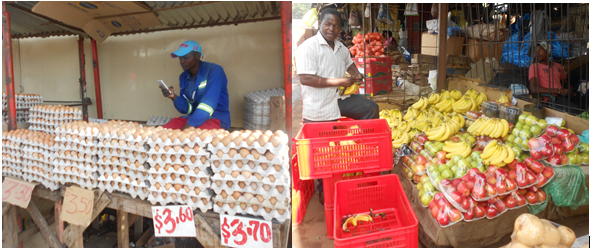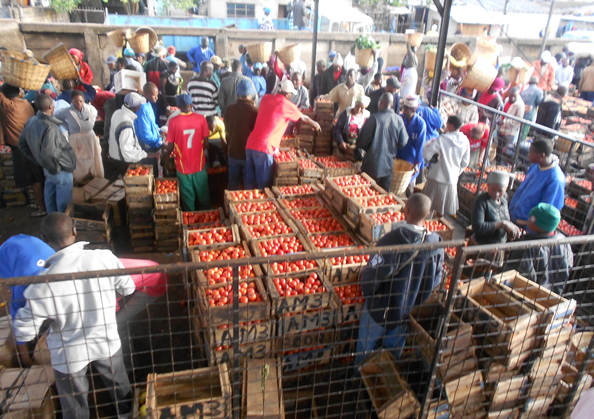A big picture of African agriculture cannot emerge without analysing the role of food vendors. In almost every African country, food vendors have a distinct position between the market and end-users or consumers. The free dictionary (http://www.thefreedictionary.com/vending ) defines vending as engaging in selling or supplying a product/service to a business for a fee. In big African cities such as Yaounde, Johannesburg, Nairobi, Maputo, Harare, Accra, Cairo, Lagos, Lusaka and Addis Ababa, food vendors are always seen early in the morning, buying fresh agricultural commodities from people’s markets and taking the commodities to residential areas or streets. Major food commodities they buy and sell include tomatoes, leafy vegetables, eggs, meat, fruits, fish and all kinds of juices. The main difference between vendors and traders is that most traders have permanent stalls in the market while vendors sell from high density areas or in streets. However, since vending can be more of a practice, there are times where traders also act like vendors.
How food vendors come into agricultural value chains
From its work in agriculture markets of Zimbabwe, eMKambo has discovered the unique role of food vendors in agricultural value chains. Given similarities between African agro-based economies, these findings may resonate with many African countries which are also trying to modernise agriculture.

Among all agricultural value chain actors, vendors are more close to end users. The only difference is during few cases where end users buy directly from food chain stores or the wholesale market. Vendors have a particular niche market comprising households with particular tastes and preferences. They even have specific information about particular households including details like income sources and income levels. They also have an acute sense of demand in terms of standards, specifications and volumes. When a 30 toner truck of potatoes gets into Mbare wholesale market in Harare, for instance, three quarters of the commodity ends up with vendors whose understanding of consumers result in the consignment being classified into at least three grades by quality and quantity.
Since they are close to end-users from whom they take orders, vendors can also adjust orders accordingly. They even know how many tomatoes are consumed by a particular household. This intimate awareness informs the arrangement of tomato fruits in terms of size and number in a pile. For three to six months each vendor can use at least $50 to buy commodities and still get the same profit margin. They are also good at adjusting and balancing the demands and supply trends. If they find tomatoes very expensive in the market, they can use some of the money to buy a cheaper fruit such as a banana or go for lower grade tomatoes which they are sure end-users want.

Vendors as knowledge brokers
Statistics from vendors are more accurate and represent effective demand as an expression of end users’ ability and willingness to purchase. Since it is often very difficult to determine effective demand from the supply side, vendors close the knowledge gap. If five tons of tomatoes are delivered in the farmers market, up to 20% can be lost in the marketing process through offloading, re-loading and mishandling. Less than 5% is lost at vendor and household level. In fact, the loss at vendor and household level is not in the form of throwing away. Some commodities can be given customers on credit to avoid complete losses.
By conveying important feedback from consumers to farmers through traders and the whole market, vendors have become important knowledge brokers regarding consumption patterns and consumer preferences. The strong relationship between vendors and end-users creates room for unique credit models based on specific orders. Vendors can show different classes of consumers, their levels of income and preferences. This is very important for every producer to know. A quick survey can show three to four different types of vegetables on the market in high density areas – leafy vegetables, tomatoes and onions. Fruits are there but sometimes rare. If you go to high density areas, leafy vegetables on the market are in the form of lettuce, broccoli, fine beans, etc. This means vendors can show and define incomes and preferences in particular areas. Vendors also extend knowledge on food preparation to young mothers who, for instance, struggle with cooking pumpkin leaves and okra.
Because they have a lot of time to interact with consumers, most vendors are good marketers. More than 80% of food goes through vendors to end-users. The growth of SMEs is supported by vendors who provided mobile food catering services. Unfortunately, conventional agricultural production models being promoted in Africa overlook the importance of understanding actors like vendors at a granular level. It seems the preferred notion of value chain is more about contract farming and super markets, ignoring the mass market where vendors are critical actors.
The expansion of food vending into rural growth points and business centres is in response to rapid urbanisation and an increase in youthful population now residing in these centres. As a food distribution mechanism, rural vendors take commodities from urban markets to rural areas where nurses, teachers and other government employees are the main market. While you can place an order with a vendor and be assured of a commodity coming, you cannot do the same with food chain stores.
Towards vendor-driven finance models
Vendors are the main conduit through which money is collected from households to major markets such as Mbare or Bulawayo and then to farmers. Wholesale markets on their own may not be viable without vendors. It doesn’t help to finance big actors while ignoring vendors. Vending is another way through which young people can develop a passion and an entrepreneurial mind set around agriculture. Children of vendors can automatically see how agriculture is a source of employment more than those on the production side who sometimes do not see income from agriculture activities. Vendors determine 70% of prices of commodities on the farmers’ market using feedback from end-users. They can increase or decrease volumes based on orders from end-users or how yesterday’s consignment performed. They are also good in managing liquidity issues and can loan out commodities to households based on relationships with payment being done later on.
Formal companies which specialize in eggs, bananas and all kinds of juices depend heavily on vendors for higher sales. The vendors also influence packaging. For instance, some beverages which used to come in 500ml containers can now be seen in 100ml containers. These changes come from vendors who know consumers’ buying power and preferences. The smallest unit of measurement can be found at vendor level. They add value and provide the exact preferences in terms of quantities. By bringing food closer to homes, vendors minimize losses and ensure freshness of commodities. For some consumers, refrigerated tomatoes don’t taste as good as fresh ones from the market or farm. Value addition at the vendor level should also be a serious consideration. Because they know customer preferences, vendors can produce the right tomato puree and fruit juices that really meet customer requirements.
How understanding food vendors can inform policy making
There is a dominance of women in the vending business because the business is closer to food preparation, which is a domain of women. Women vendors know perishability characteristics of diverse food items as well as quality issues to minute detail. Destroying vending as a business affects women more than men. In recognition of vending as an important agribusiness, local authorities should ensure vending stalls and related structures are part of every business ecosystem. It is very important for policy makers to understand linkages between food vendors and formal organisations such as wholesalers and processors. The prevalence of many stories about vendors in African cities being chased away from streets or relocated to areas where they eventually run away suggests that policy makers and local authorities do not see vendors as part of modern African cities. While there is a tendency to think that vendors operate outside regulations, the majority operate within by-laws and regulatory frameworks. However, they lack effective legal rights and bargaining power on important issues like security of workplace and access to basic infrastructure. A firm grasp of vendors’ daily work processes can result in urban planners designing appropriate structures for a more supportive and dynamic agriculture-supported urban African economies. Making basic infrastructure such as running water and toilets available to vendors would help keep food markets more hygienic. Adequate shelter and storage facilities would help vendors protect their goods from spoilage and theft, in turn reducing the necessity of borrowing from informal moneylenders to replenish their stocks.
Towards a human – centred policy approaches
Local authorities and policy makers should embrace a Human – Centred Design approaches to urban planning where they spend significant amount of time and resources understanding vendors and other actors. Policy makers should try to get out of their heads and look at challenges from different perspectives. Jumping to solutions is not a smart solution. To accurately deliver services in the knowledge economy, decision makers have to understand what really happens to food when delivered in the market. A farmer should not just be satisfied with ending at the market. It is becoming important to get insights from end-users. Modernising agriculture is not just about mechanisation but understanding what happens to food from farm to consumer.
Contacts
charles@knowledgetransafrica.com / charles@emkambo.co.zw / info@knowledgetransafrica.com
Website: www.emkambo.co.zw / www.knowledgetransafrica.com
eMkambo Call Centre: 0771 859000-5/ 0716 331140-5 / 0739 866 343-6
